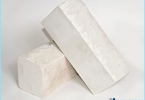The contents
- The types of compositions
- The main components of
- The characteristics and the proportions of the various solutions
The question of how the right to prepare for masonry mortar based on cement with the years not lost its relevance. Despite the seeming simplicity of the process, it has nuances, knowledge of which will help to avoid mistakes. A Testament to the versatility of the subject is the mystery of preparation of the compositions used in the construction of ancient temples, which has maintained its integrity before our time.
Vehicles ↑
To create a solid brickwork used mortars of different types. The technology of their preparation has a certain similarity. Any part of the masonry brick has three key components: the filler, which is often sand, binder and water. The key difference is in the binder element. Greater viscosity or plasticity help additional substances in the form of clay, PVA glue and other additives.
Cement is the main binder component in the preparation for bricklaying mortar. In addition to her perform these functions:
- lime;
- clay;
- cement-lime mix.
On the basis of technological properties, it is possible to prepare cement compositions for bricklaying:
- Skinny. Have a small amount of binder. They tend to have low ductility and strength, which will further lead to cracking of the material. A positive point is the cheapness of the mixture.
- Fat. Contain an increased amount of binder component. The ductility and high strength in this case is guaranteed, but there is a tendency to cracking and the risk of shrinkage during solidification.
- To optimally prepare the normal mortar, where the proportions contributes to the preservation of all the positive qualities for bricklaying.

The main components ↑
Careful selection of the main components of cement mortar will allow to make high-quality mass that will provide a solid masonry brick. To do this:
- Water for kneading required clean, free of impurities, dirt and foreign substances. Is to dial it from the well. The temperature of the liquid depends on the season when you want to prepare a cement mass in summer suitable cold water, in winter it needs extra heating.
- Sand is an integral component of the cement composition. No traces of clay and other impurities are required, otherwise, the company weathered mortar from brickwork will accelerate. The Council! To determine the quality of sand directly in the purchase easily. Intense yellow color indicates the presence of additional impurities, so prepare with it a solution is possible only for zabudovanou masonry.
- The main component that determines the properties of the future composition of the cement is. In order to correctly prepare a solution and to observe the correct proportions, the key is grade cement mixture. There is a pattern: the higher the grade of the binder component, the smaller the amount needed to prepare a solution. If you wish to prepare a composition of a darker shade, it is sufficient to add graphite or carbon black, or buy a higher grade of cement. At the same time to monitor the consistency of the proportions definitely!
- To prepare the cement mass without buying expensive softeners help detergents. This role will suit shampoo, washing powder or liquid for washing dishes. The exception is cleaner because of the probability of occurrence of cracks in the brickwork.

The characteristics and the proportions of the various solutions ↑
In addition to cement mortar in pure form for bricklaying periodically apply lime and cement-lime mixture. Properties, proportions and in some cases it is better to cook each type, we consider in detail.
Limy ↑
Lime mortar for brick masonry is rarely used, due to the deterioration of the strength. His main area of operation – chimney bricks or masonry Foundation for the oven. The proportions of mortar for these purposes vary based on fat lime. To prepare an optimum composition, one part binder component is added from 2 to 5 parts of sand.
Cement and cement-limy ↑
Laying bricks continued popularity among builders uses cement mortar. Its distinguishing characteristics are:
- increased rigidity;
- the coldest structure among all the species;
- however, these characteristics and at the same time provide increased strength.
The plasticity of the composition is directly connected with the proportions of the insertion components. Starting from the brand dry cement mixture and of the requirements for bricklaying, mortar formed in proportions similar to a lime composition at a fraction of the binder component is added from 2 to 5 fraction of sand.

Milk of lime increases the plasticity of the composition compared to pure cement option. It is getting warmer, while retaining the necessary strength that provides a wide range of applications. The only condition – the impossibility of application, if the humidity is above the norm. The optimal proportions of the cementitious components (cement and lime) and filler are:
- for mortar M25 – 1/1/4;
- for mortar M50 – 1/0,5/4,5.

The technology of preparation ↑
The secret how to prepare high quality mortar designed for laying brick, is extremely simple – measure the correct amounts. Please prepare the tools: clean bucket, surround mixing container, shovel and trowel.
To speed up the whole process of masonry will help the use of mixers (if you have a team of builders), for small amounts of the cement mixture is better to mix by hand. To do this:
- To prepare to use sand by sieving for the purpose of cleaning away debris and impurities. It is advisable to use river sand, if there is a career, the limit of the fraction is not more than 2.5 mm.
- Capacity fill with cement and sand. If the exact proportions for masonry bricks is unknown, it is better to prepare the classic version – for 1 bucket of cement to add 4 buckets of sand. When mixed, the outcome is a 40 l mixture, rather than the expected 50 l, with cement filling the space between the sand. Attention! The number of required components is calculated by the volume of the container in litres, to focus on the weight in kilograms not.
- Preliminary components of the future cement mortar mixed thoroughly until smooth, then add the water. The average rate is 0.8 liters per 1 kg of cement. Cement mortar it is desirable to prepare water at room temperature (in the range of 15-20onC). The procedure of gradual adding of liquid accompanied by periodic stirring of the composition for bricklaying. Otherwise, the heavy sand will settle to the bottom and squeeze the water up.
If you prepare a cement weight was right, and all the proportions had been respected for its consistency, it will resemble the homemade thick cream.
Requirements for the final composition ↑
To the masonry brick did not disappoint in the near future, the prepared cement supply must comply with the requirements:
- The plasticity of the composition. This affects the filling of voids and irregularities in the masonry of brick.
- High adhesion level with a brick.
- Optimum setting time. Quick freezing makes it impossible normal work process. Cement formulations should maintain flexibility over one and a half to two hours. When you add the lime period is extended for another 3 hours.
- A quality solution ensures the formation of a thin uniform layer.
- After hardening the mixture should retain strength, otherwise the bricks will undergo deformation.
- Has sufficient insulating properties.

To modify the plasticity and mobility of the prepared cement mixture will allow the introduction of plasticizers. In addition to the standard surface-active agents, there are also a popular way to form conventional detergents.
Compliance with recommendations will allow you to correctly prepare a solution of cement, which will contribute to the quality of the construction process.







